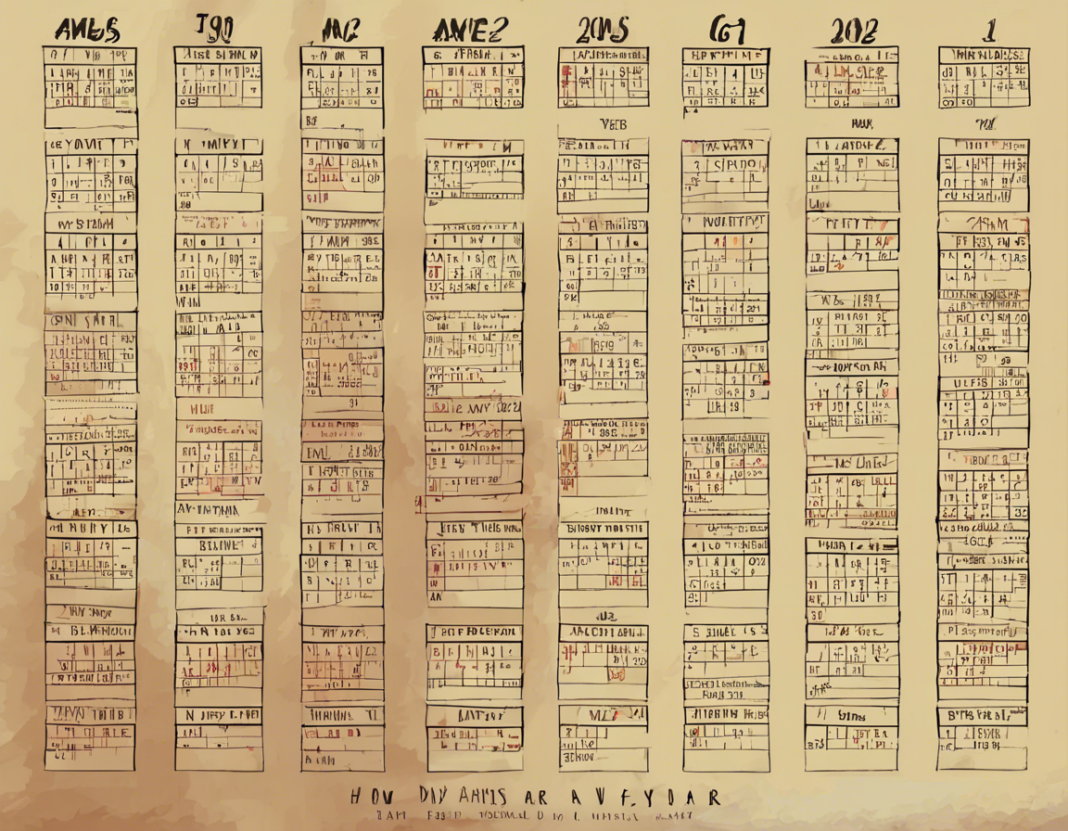Do you ever stop to think about the concept of time and how we measure it? One of the most fundamental units of time is the year, a period encompassing 365 days. This cycle around the sun has been a cornerstone of human civilization for millennia, influencing everything from agriculture and astronomy to cultural traditions and personal reflections. In this comprehensive guide, we will delve into the intricacies of a year, exploring its origins, significance, and interesting facts.
The Origins of a Year
The concept of a year is deeply rooted in astronomy and the Earth’s movement around the sun. The time it takes for our planet to complete one full orbit is approximately 365.25 days, which we round down to 365 days for the sake of simplicity. This orbital period creates the changing seasons as the Earth tilts on its axis, exposing different hemispheres to varying amounts of sunlight throughout the year.
Ancient civilizations, such as the Egyptians and Babylonians, were among the first to develop calendars based on the solar year. They observed the movements of the stars and planets to track the passage of time and align their agricultural and religious activities with the changing seasons. These early calendars laid the foundation for the modern Gregorian calendar that much of the world uses today.
The Gregorian Calendar
The Gregorian calendar, introduced by Pope Gregory XIII in 1582, refined the Julian calendar that had been in use for centuries. The Julian calendar, established by Julius Caesar in 46 B.C., had a small error in its calculation of the solar year, leading to discrepancies over time. To correct this, the Gregorian calendar introduced the concept of leap years, adding an extra day to February every four years to account for the extra 0.25 days in the solar year.
Today, the Gregorian calendar is the most widely used calendar system globally, with 12 months and 365 days in a common year. Leap years occur every four years, except for years evenly divisible by 100 (e.g., 1900), unless they are also evenly divisible by 400 (e.g., 2000). This adjustment ensures that our calendar stays in sync with the Earth’s orbit, preventing seasonal drift over centuries.
Significance of a Year
The passage of a year holds great significance for individuals, communities, and cultures around the world. Here are some key aspects where a year plays a crucial role:
Agricultural Cycles
- Farmers rely on the changing seasons to plant, harvest, and rotate crops effectively.
- Animal migration patterns and breeding seasons are tied to the passage of a year.
Cultural Celebrations
- Many holidays and festivals are based on the changing seasons and significant dates throughout the year.
- New Year’s Eve, a universal celebration, marks the end of one year and the beginning of the next.
Personal Reflection
- A year provides a natural timeline for setting goals, reflecting on achievements, and planning for the future.
- Birthdays and anniversaries allow individuals to mark the passage of time and celebrate milestones.
Astronomical Observations
- The positions of the sun, moon, and stars relative to Earth change throughout the year, influencing astronomy and navigation.
- Solstices and equinoxes mark key points in the Earth’s orbit and have cultural significance in many societies.
Interesting Facts About a Year
- The Earth’s orbit is not a perfect circle but an ellipse, varying in distance from the sun throughout the year.
- The term “year” is derived from the Old English word “gear,” meaning a full cycle of seasons.
- The tropical year, based on the equinoxes, is about 365.2422 days long, slightly shorter than the sidereal year of 365.2564 days.
- Different cultures have unique ways of measuring a year, such as the lunar calendar used in Islamic traditions.
FAQ: Frequently Asked Questions
1. How many days are in a year?
A common year has 365 days, while a leap year has 366 days with an extra day added to February.
2. Why do we have leap years?
Leap years are added to the calendar to account for the extra 0.25 days in the Earth’s orbit around the sun, keeping our calendar in sync with the seasons.
3. What is the significance of the Gregorian calendar?
The Gregorian calendar is widely used globally for official and civil purposes, providing a consistent way to track time and schedule activities.
4. Are there other ways to measure a year?
Yes, different cultures and traditions have their own calendar systems, such as the lunar calendar and the lunisolar calendar, based on the moon’s phases.
5. How do leap years affect my birthday?
If you were born on February 29th, known as a leap day, you technically only celebrate your “true” birthday every four years.
6. What is the longest and shortest day of the year?
The summer solstice marks the longest day with the most sunlight, while the winter solstice has the shortest day and longest night.
7. How can I calculate the day of the week for any date in history?
You can use algorithms like Zeller’s Congruence or the Doomsday Rule to determine the day of the week for a given date.
8. Are there cultures that don’t follow the Gregorian calendar?
Yes, some cultures, particularly indigenous and traditional societies, use their own calendar systems based on local astronomical observations and cultural practices.
9. Why do some calendars start on different months?
The choice of starting month for a calendar is often historical or cultural, influenced by events, leaders, or significant celestial occurrences.
10. How does daylight saving time affect the length of a day?
Daylight saving time shifts the clock forward or backward, altering the perceived length of a day for energy conservation and practical purposes.
As we journey through each year, let’s savor the rhythms of time that shape our lives and connect us to the universe. Remember that while a year may seem like a simple unit of time, it carries profound symbolism and significance that transcends mere measurement. Embrace the changing seasons, celebrate each milestone, and make the most of every 365-day cycle on this beautiful planet we call home.

